Page 507 of 2543
7. REMOVE REAR CENTER FLOOR CROSSMEMBER
BRACE
Torque: 13 NVm (130 kgfVcm, 9 ftVlbf)
8. REMOVE PROPELLER SHAFT
(See page PR±7)
9. DISCONNECT SHIFT CONTROL ROD FROM SHIFT
LEVER
Torque: 13 NVm (130 kgfVcm, 9 ftVlbf)
INSTALLATION HINT: Inspect and adjust the park/ neutral
position switch. (See page AT2±43)
10. REMOVE SHIFT CONTROL ROD FROM PARK/NEUTRAL
POSITION SWITCH
Torque: 16 NVm (160 kgfVcm, 12 ftVlbf)
11. DISCONNECT THESE CONNECTORS:
wO/D direct clutch speed sensor
wNo.1 vehicle speed sensor
wNo.2 vehicle speed sensor
wSolenoid wire
wPark/neutral position switch
wA/T fluid temp. sensor
12. D I S C O N N E C T C O N N E C TO R S A N D C A B L E F R O M
STARTER
(a) Remove the nut and disconnect the wire harness.
(b) Disconnect the connectors.
± A340E (2JZÐGTE) AUTOMATIC TRANSMISSIONASSEMBLY REMOVAL AND INSTALLATIONAT2±23
Page 521 of 2543
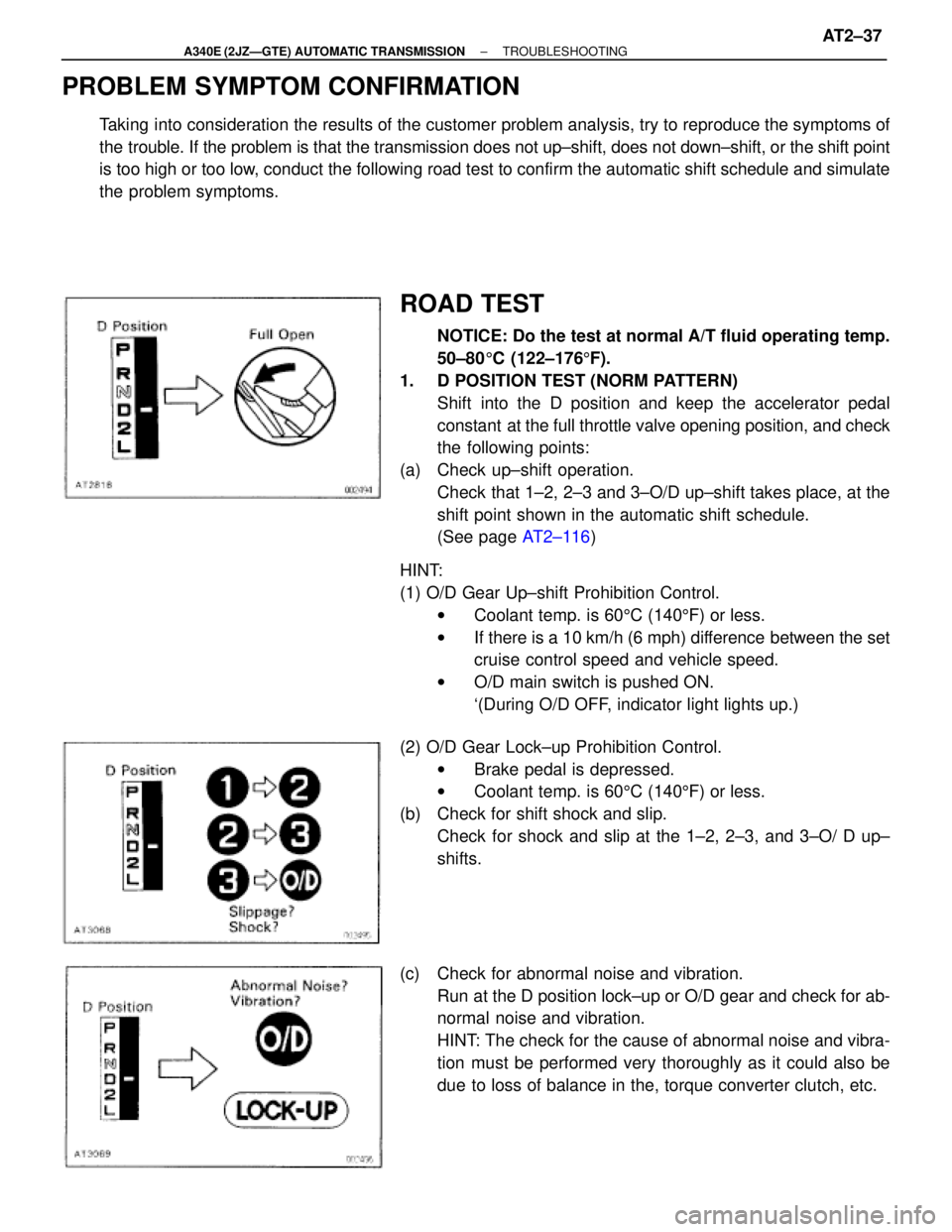
PROBLEM SYMPTOM CONFIRMATION
Taking into consideration the results of the customer problem analysis, try to reproduce the symptoms of
the trouble. If the problem is that the transmission does not up±shift, does not down±shift, or the shift point
is too high or too low, conduct the following road test to confirm the automatic shift schedule and simulate
the problem symptoms.
ROAD TEST
NOTICE: Do the test at normal A/T fluid operating temp.
50±805C (122±1765F).
1. D POSITION TEST (NORM PATTERN)
Shift into the D position and keep the accelerator pedal
constant at the full throttle valve opening position, and check
the following points:
(a) Check up±shift operation.
Check that 1±2, 2±3 and 3±O/D up±shift takes place, at the
shift point shown in the automatic shift schedule.
(See page AT2±116)
HINT:
(1) O/D Gear Up±shift Prohibition Control.
wCoolant temp. is 605C (1405F) or less.
wIf there is a 10 km/h (6 mph) difference between the set
cruise control speed and vehicle speed.
wO/D main switch is pushed ON.
`(During O/D OFF, indicator light lights up.)
(2) O/D Gear Lock±up Prohibition Control.
wBrake pedal is depressed.
wCoolant temp. is 605C (1405F) or less.
(b) Check for shift shock and slip.
Check for shock and slip at the 1±2, 2±3, and 3±O/ D up±
shifts.
(c) Check for abnormal noise and vibration.
Run at the D position lock±up or O/D gear and check for ab-
normal noise and vibration.
HINT: The check for the cause of abnormal noise and vibra-
tion must be performed very thoroughly as it could also be
due to loss of balance in the, torque converter clutch, etc.
± A340E (2JZÐGTE) AUTOMATIC TRANSMISSIONTROUBLESHOOTINGAT2±37
Page 526 of 2543
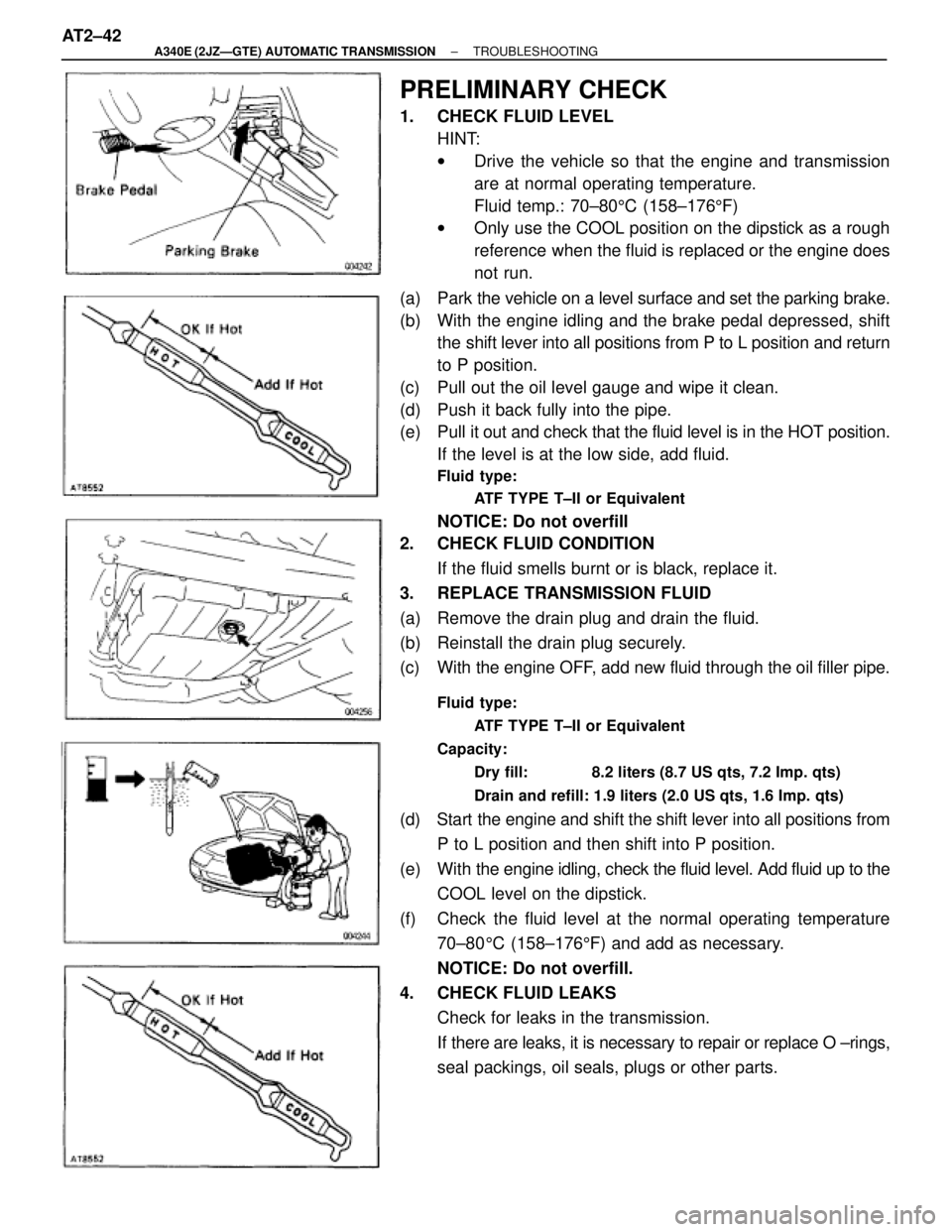
PRELIMINARY CHECK
1. CHECK FLUID LEVEL
HINT:
wDrive the vehicle so that the engine and transmission
are at normal operating temperature.
Fluid temp.: 70±805C (158±1765F)
wOnly use the COOL position on the dipstick as a rough
reference when the fluid is replaced or the engine does
not run.
(a) Park the vehicle on a level surface and set the parking brake.
(b) With the engine idling and the brake pedal depressed, shift
the shift lever into all positions from P to L position and return
to P position.
(c) Pull out the oil level gauge and wipe it clean.
(d) Push it back fully into the pipe.
(e) Pull it out and check that the fluid level is in the HOT position.
If the level is at the low side, add fluid.
Fluid type:
ATF TYPE T±II or Equivalent
NOTICE: Do not overfill
2. CHECK FLUID CONDITION
If the fluid smells burnt or is black, replace it.
3. REPLACE TRANSMISSION FLUID
(a) Remove the drain plug and drain the fluid.
(b) Reinstall the drain plug securely.
(c) With the engine OFF, add new fluid through the oil filler pipe.
Fluid type:
ATF TYPE T±II or Equivalent
Capacity:
Dry fill: 8.2 liters (8.7 US qts, 7.2 Imp. qts)
Drain and refill: 1.9 liters (2.0 US qts, 1.6 Imp. qts)
(d) Start the engine and shift the shift lever into all positions from
P to L position and then shift into P position.
(e) With the engine idling, check the fluid level. Add fluid up to the
COOL level on the dipstick.
(f) Check the fluid level at the normal operating temperature
70±805C (158±1765F) and add as necessary.
NOTICE: Do not overfill.
4. CHECK FLUID LEAKS
Check for leaks in the transmission.
If there are leaks, it is necessary to repair or replace O ±rings,
seal packings, oil seals, plugs or other parts. AT2±42
± A340E (2JZÐGTE) AUTOMATIC TRANSMISSIONTROUBLESHOOTING
Page 528 of 2543
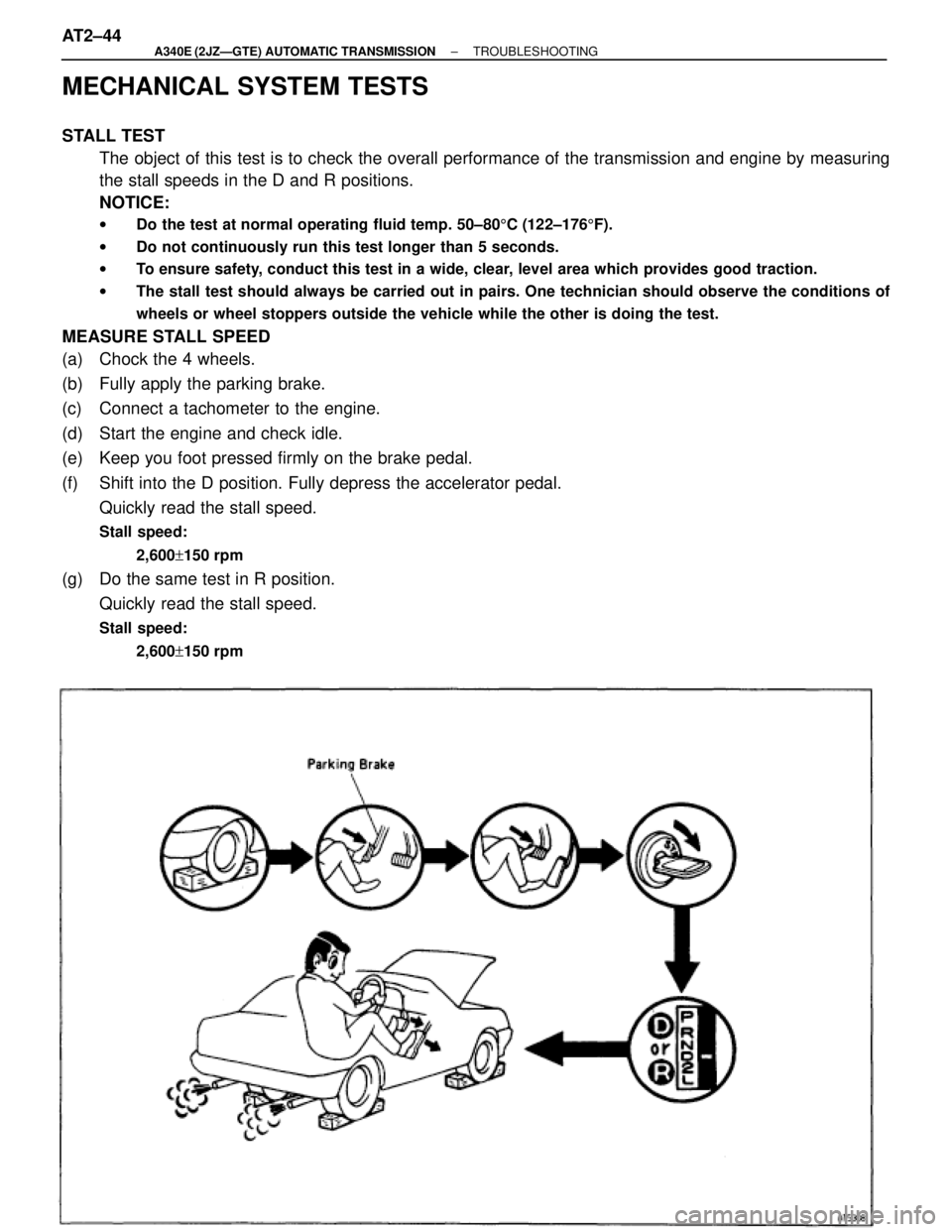
MECHANICAL SYSTEM TESTS
STALL TEST
The object of this test is to check the overall performance of the transmission and engine by measuring
the stall speeds in the D and R positions.
NOTICE:
wDo the test at normal operating fluid temp. 50±805C (122±1765F).
wDo not continuously run this test longer than 5 seconds.
wTo ensure safety, conduct this test in a wide, clear, level area which provides good traction.
wThe stall test should always be carried out in pairs. One technician should observe the conditions of
wheels or wheel stoppers outside the vehicle while the other is doing the test.
MEASURE STALL SPEED
(a) Chock the 4 wheels.
(b) Fully apply the parking brake.
(c) Connect a tachometer to the engine.
(d) Start the engine and check idle.
(e) Keep you foot pressed firmly on the brake pedal.
(f) Shift into the D position. Fully depress the accelerator pedal.
Quickly read the stall speed.
Stall speed:
2,600+150 rpm
(g) Do the same test in R position.
Quickly read the stall speed.
Stall speed:
2,600+150 rpm
AT2±44± A340E (2JZÐGTE) AUTOMATIC TRANSMISSIONTROUBLESHOOTING
Page 529 of 2543
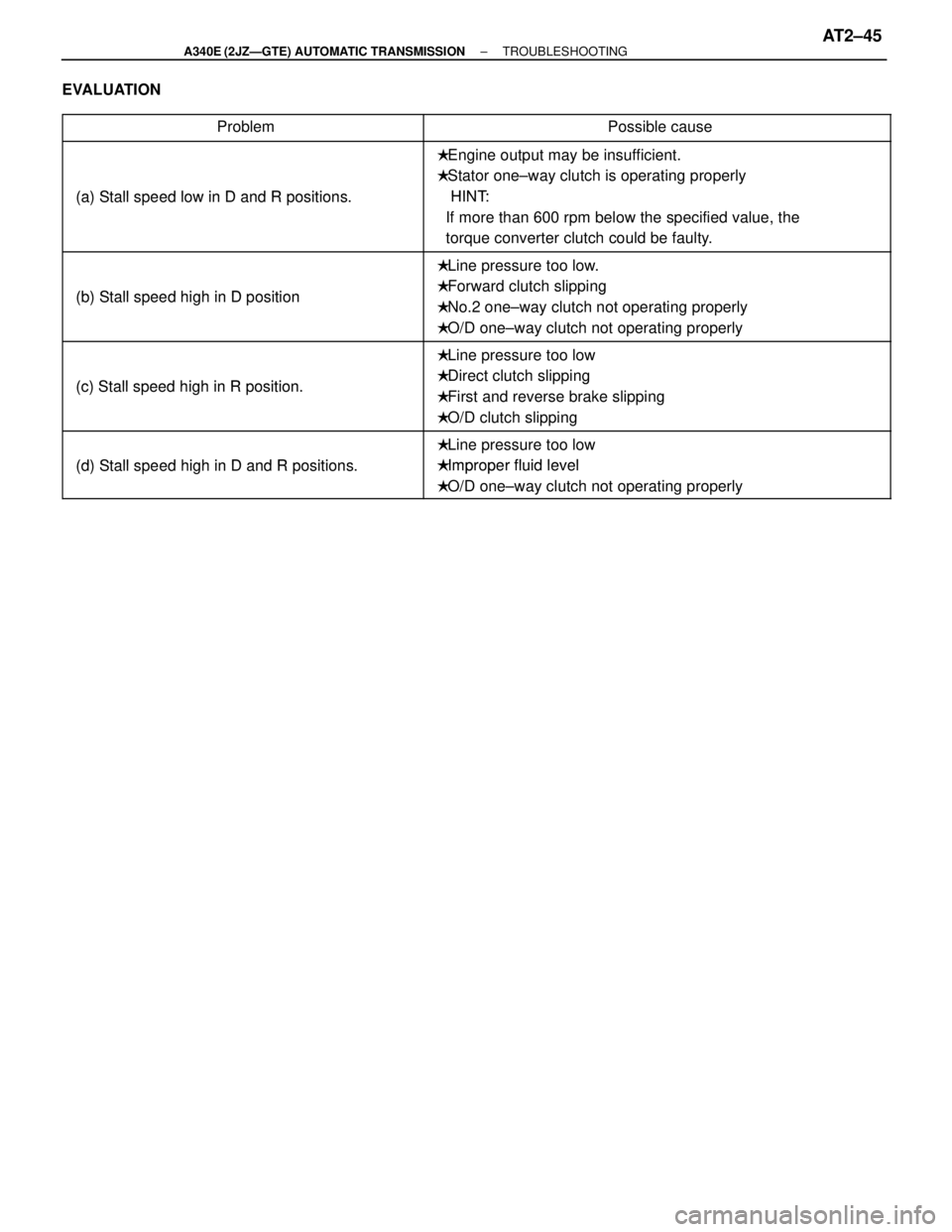
EVALUATION
���������������� ����������������Problem��������������������� ���������������������Possible cause���������������� �
��������������� �
��������������� ����������������(a) Stall speed low in D and Rpositions
� Engine output may be insufficient.
� Stator one±way clutch is operating properly
HINT:���������������� �
��������������� ����������������
(a) Stall speed low in D and R positions. HINT:
If more than 600 rpm below the specified value, the
torque converter clutch could be faulty.
���������������� �
��������������� ����������������(b) Stall speed high in Dposition
� Line pressure too low.
� Forward clutch slipping
���������������� �
��������������� ����������������
(b) Stall speed high in D position Forward clutch sli ing
� No.2 one±way clutch not operating properly
� O/D one±way clutch not operating properly
���������������� �
��������������� ����������������(c) Stall speed high in Rposition
� Line pressure too low
� Direct clutch slipping
���������������� �
��������������� ����������������
(c) Stall speed high in R position. Direct clutch sli ing
� First and reverse brake slipping
� O/D clutch slipping
���������������� ����������������
(d) Stall speed high in D and Rpositions
� Line pressure too low
�Improper fluid level���������������� ����������������(d) Stall speed high in D and R positions.� Improper fluid level
� O/D one±way clutch not operating properly
± A340E (2JZÐGTE) AUTOMATIC TRANSMISSIONTROUBLESHOOTINGAT2±45
Page 530 of 2543
TIME LAG TEST
When the shift lever is shifted while the engine is idling, there will be a certain time lapse or lag before the
shock can be felt. This is used for checking the condition of the O/D direct clutch, forward clutch, direct
clutch, and first and reverse brake.
NOTICE:
wDo the test at normal operating fluid temp. 50±805C (122±1765F).
wBe sure to allow 1 minute interval between tests.
wTake 3 measurements and take the average value.
MEASURE TIME LAG
(a) Fully apply the parking brake
(b) Start the engine and check idle speed.
Idle speed:
650+50 rpm (In N position and air conditioner OFF)
(c) Shift the shift lever from N to D position. Using a stop watch, measure the time it takes from shifting the
lever until the shock is felt.
In same manner, measure the time lag for N " R.
Time lag:
N
"D Less than 1.2 seconds
N
"R Less than 1.5 seconds
AT2±46± A340E (2JZÐGTE) AUTOMATIC TRANSMISSIONTROUBLESHOOTING
Page 532 of 2543
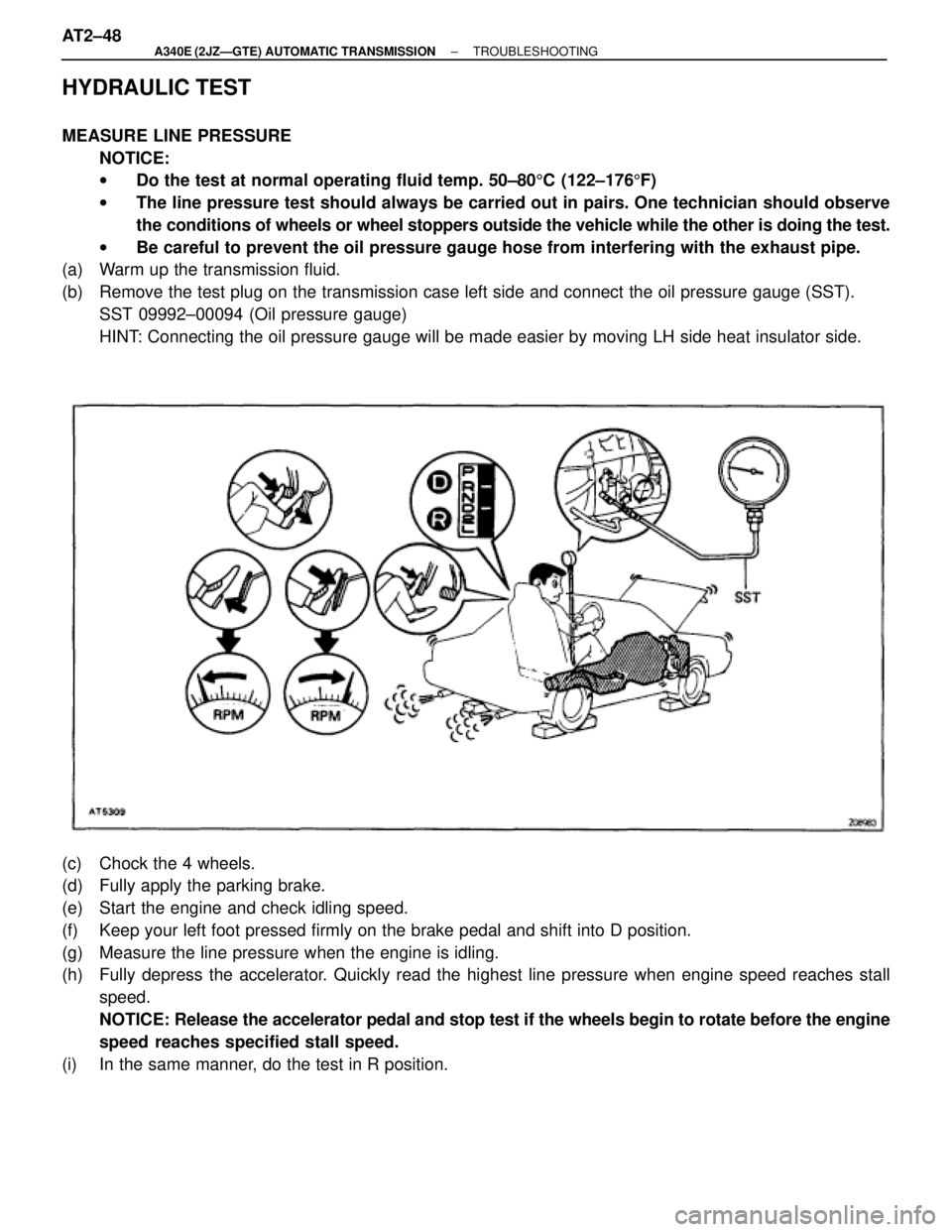
HYDRAULIC TEST
MEASURE LINE PRESSURE
NOTICE:
wDo the test at normal operating fluid temp. 50±805C (122±1765F)
wThe line pressure test should always be carried out in pairs. One technician should observe
the conditions of wheels or wheel stoppers outside the vehicle while the other is doing the test.
wBe careful to prevent the oil pressure gauge hose from interfering with the exhaust pipe.
(a) Warm up the transmission fluid.
(b) Remove the test plug on the transmission case left side and connect the oil pressure gauge (SST).
SST 09992±00094 (Oil pressure gauge)
HINT: Connecting the oil pressure gauge will be made easier by moving LH side heat insulator side.
(c) Chock the 4 wheels.
(d) Fully apply the parking brake.
(e) Start the engine and check idling speed.
(f) Keep your left foot pressed firmly on the brake pedal and shift into D position.
(g) Measure the line pressure when the engine is idling.
(h) Fully depress the accelerator. Quickly read the highest line pressure when engine speed reaches stall
speed.
NOTICE: Release the accelerator pedal and stop test if the wheels begin to rotate before the engine
speed reaches specified stall speed.
(i) In the same manner, do the test in R position. AT2±48
± A340E (2JZÐGTE) AUTOMATIC TRANSMISSIONTROUBLESHOOTING
Page 533 of 2543

SPECIFIED LINE PRESSURE
Line pressure:
���������� ����������Condition��������������� ���������������D position kPa (kgf/cm2 psi)������������� �������������R position kPa (kgf/cm2, psi)���������� ����������Idling471±530 (4 8±5 4 68±77)686±785 (7 0±8 0 100±114)����������Idling471±530 (4.8±5.4, 68±77)686±785 (7.0±8.0, 100±114)���������� ����������
Stall1 334±1 470 (13 6±15 0 193±213)1 697±2 030 (17 3±20 7 246±294)���������� ����������Stall1,334±1,470 (13.6±15.0, 193±213)1,697±2,030 (17.3±20.7, 246±294)
If the measured pressures are not up to specified values, check the No.5 solenoid valve and retest.
EVALUATION������������������ �
�����������������
������������������
Problem
������������������ �
����������������� ������������������Possible cause
������������������ ������������������
If the measured values at allpositions are higher
� Throttle cable out of adjustment
�Throttle valve defective������������������ ������������������If the measured values at all positions are higher.� Throttle valve defective
� Regulator valve defective
������������������ �
�����������������
������������������
������������������If the measured values at allpositions are lower
� Throttle cable out of adjustment
� Throttle valve defective
�Regulator valve defective������������������ �
�����������������
������������������
If the measured values at all positions are lower.� Regulator valve defective
� Oil pump defective
� O/D direct clutch defective
������������������ ������������������
Ifpressure is low in the Dposition only� D position circuit fluid leakage
������������������ ������������������If pressure is low in the D position only.g
� Forward clutch defective
������������������ �
�����������������
������������������
Ifpressure is low in the Rposition only
� R position circuit fluid leakage
�Direct clutch defective
������������������ ������������������
If pressure is low in the R position only.� Direct clutch defective
� First and reverse brake defective
± A340E (2JZÐGTE) AUTOMATIC TRANSMISSIONTROUBLESHOOTINGAT2±49